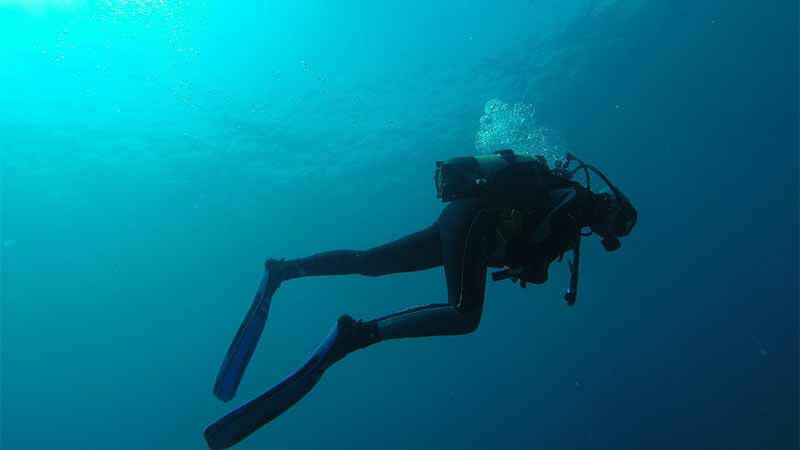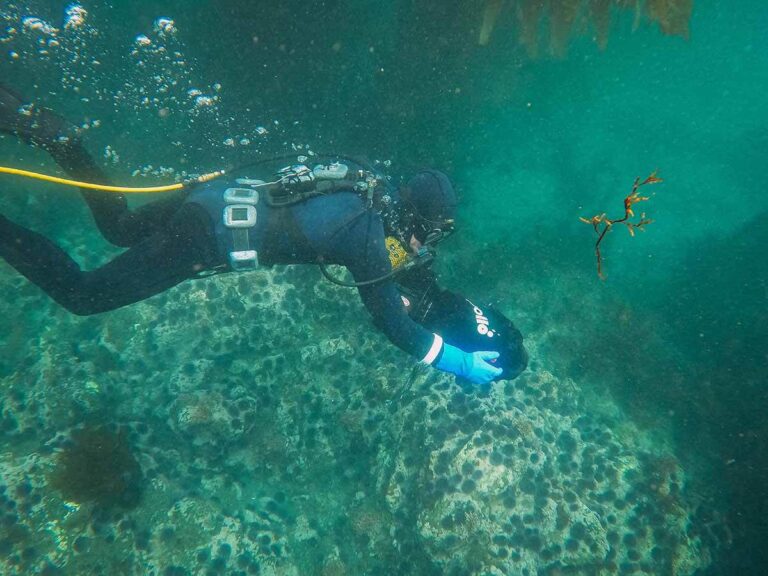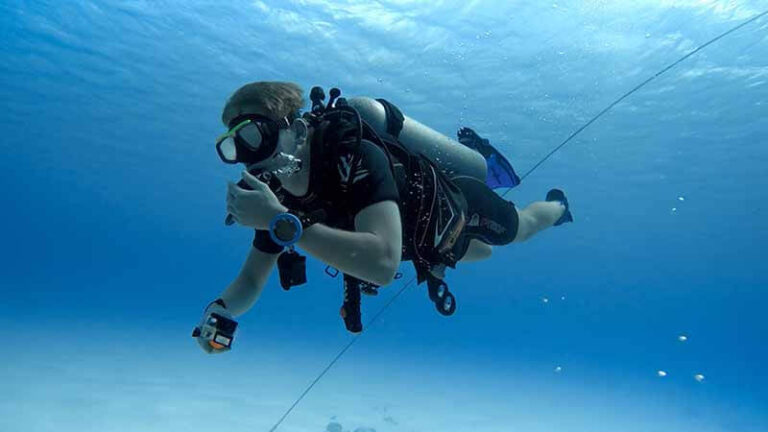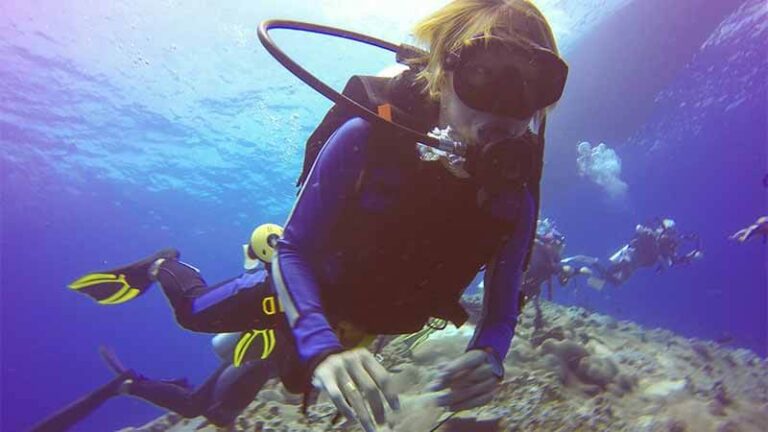5 Best Scuba Diving Fins of 2023
Scuba diving is an incredible adventure that brings you to the depths of the ocean, but in order to really enjoy your dive, you must have the proper equipment. One of the most important parts of dive equipment is a set of fins. A decent pair of fins may make or break your dive experience by providing the propulsion and maneuverability you need to easily explore the underwater world.
Choosing the best scuba diving fins might be difficult with so many possibilities. But don’t worry, we’ll break down the essential variables to consider and review the best scuba diving fins on the market to help you choose the perfect pair for your diving needs in this blog post.
What are the Best Scuba Diving Fins?
Here are my top picks of the best scuba diving fins for you to enjoy the dive.
1. Tusa SF-22 Scuba Diving Fins ($139)
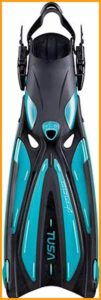
The Tusa SF-22 Scuba Diving Fins are cutting-edge diving equipment that is designed to deliver improved performance and comfort for divers. Force Last Technique powers the fins, a proprietary technology that improves power transmission from the foot pocket to the blade, giving the fins additional propulsion. Another patented design component that contributes to the efficiency of the fins is the 20° Angled Blade Design (A.B.D.).
The multi-compound foot pocket is ergonomically intended to maximize power transfer while being comfortable. The newly developed anatomic foot pocket takes comfort to the next level, allowing divers to use the fins for extended periods of time without pain. The three-channel blade with a crescent tip maximizes propulsion and control, making the SF-22 fins ideal for a variety of diving sports.
The reinforced blade side rails and vents are intended to improve efficiency and performance, allowing divers to swim with ease and confidence. The Anatomic Fin Strap (A.F.S.) that comes standard with the fins is designed to give a secure and comfortable fit. The Tusa SF-22 Scuba Diving Fins are a high-end product that provides divers with the ultimate in comfort, performance, and efficiency.
2. SEAC Scuba Diving Fins ($109)
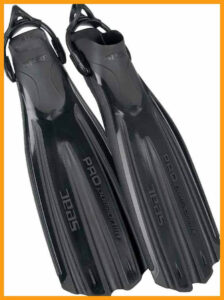
SEAC Scuba Diving Fins are engineered to deliver exceptional performance for divers of all levels, making them appropriate for a variety of diving settings. These fins will function with toughness and tenacity whether you’re exploring a warm, tropical reef or navigating cooler waters. The fins are resistant to stress cracking and UV radiation, ensuring that they will weather the rigors of diving and last for many adventures.
These fins’ blades are precisely engineered to avoid lateral water dispersion, resulting in increased propulsion with less muscular effort. This revolutionary design allows divers to move more effectively and comfortably, minimizing tiredness and letting them explore for longer periods of time. The anatomical foot pocket is incorporated with the fin blade, allowing for an ideal fit that reduces ankle twisting and fatigue.
SEAC Scuba Diving Fins also have a sling strap that matches the color of the blade. This comfortable fit is appropriate for use with wetsuits and dry suit boots, as well as gloves, guaranteeing that divers have a nice, tailored fit. SEAC Scuba Diving Fins are an excellent choice for your next underwater excursion, whether you’re a seasoned pro or just getting started.
3. Cressi Scuba Diving Fins ($92.79 – $99.95)
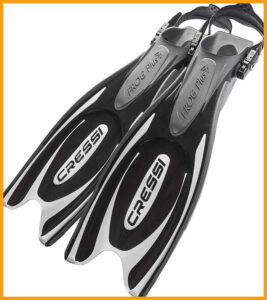
Cressi Scuba Diving Fins are high-performance diving fins for experienced divers. The innovative 3-material injection molding method creates a comfortable foot pocket and an expanded side rail for the dual-density technopolymer blade. The material combination produces a channeling effect, which maximizes energy transfer during both the up and down strokes of the kick pattern.
The revolutionary foot pocket design is located beneath the blade, increasing the blade’s operating surface area by 20% and offering increased power and efficiency. The use of a novel blade material makes these fins very robust and practically indestructible, bringing the best of both worlds by combining traditional paddle fin features with advanced materials and technology.
4. Kesida Scuba Diving Fins ($65.99)
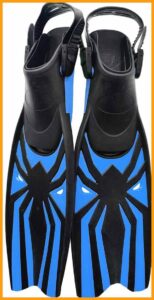
The Kesida Scuba Diving Fins are an excellent alternative for anyone seeking a versatile and portable diving solution. With three various sizes to pick from, both men and women may find the perfect fit. The adjustable heel strap ensures a secure fit, and the flexible swivel clasp makes transporting the fins to the beach simple. These fins provide adequate flexibility, allowing divers to move fast underwater.
Slipping is prevented by multi-layer symmetrical anti-slip strips on the bottom of the fins and protruding rubber dots inside the shoe, allowing divers to concentrate on their dive. The fins’ streamlined shape maximizes the force supplied by the leg muscles, while the aperture of the toe section and symmetrical drainage holes aid in water drainage, lessening the burden of diving.
5. WAVE Scuba Diving Fins ($39.99)
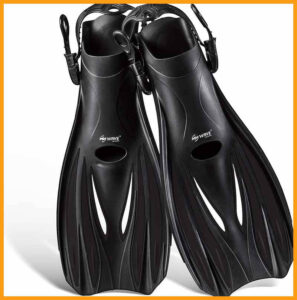
The WAVE Scuba Diving Fins are an absolute must-have for any scuba diver. These adjustable fins offer optimal comfort and convenience because they have a low foot size requirement and can be simply adjusted using the heel band to achieve a snug and secure fit. This means that each fin may fit a variety of sizes, making it simple to select the correct fit and share it with friends and family.
The fins are constructed of very elastic and soft imported TPR material, which is mechanically and abrasion resistant. They protect your ankles from cold and blisters, minimize fatigue, and avoid cramping when worn with diving socks. This significantly improves the enjoyment and comfort of your diving experience.
The fins have flexible fins and highly luminous blades that give powerful propulsion and make diving easy. This saves energy, especially in strong currents, because the fins’ capacity to push water saves a lot of energy. The revolutionary dual-turbo drag-reducing perforation design, along with diversion grooves, improves water-propelling effects and provides outstanding kick response with every stroke.
What kind of fin is best for scuba diving?
The finest scuba diving fin is determined by personal preference and diving conditions. There are two sorts of fins in general: open-heel fins and full-foot fins.
Open-heeled fins are typically worn with booties and have an adjustable strap around the heel. They give a more secure fit and are typically favored by divers who frequently dive in cold or turbulent conditions due to their increased power and control.
Full-foot fins are designed to be worn without booties and fit over the foot like a slipper. They are more compact and lighter than open-heel fins, making them excellent for travel and warm-water diving. They may not, however, provide as much power and control as open-heel fins.
Finally, the finest scuba diving fin is one that fits comfortably, produces adequate propulsion, and is suited for diving conditions. It’s critical to try on various fins and find the one that feels the most comfortable and secure to you.
How to Choose Scuba Fins?
There are various aspects to consider when selecting scuba fins to ensure that you purchase fins that are comfortable and appropriate for your diving needs. Here are some important considerations to bear in mind:
- Fin type: There are two varieties of fins: full-foot fins, which are used without boots, and open-heel fins, which are worn with boots. Choose the type you prefer and which is most suited to the type of diving you intend to conduct.
- Fin size: Fins should be snug but not too snug. To get the correct size for your foot, use the manufacturer’s sizing chart.
- Blade length: The length of the blade influences how much propulsion you can generate with each kick. Longer blades generate more power but are more difficult to utilize. Shorter blades are easier to kick and are ideal for diving in confined spaces or against strong currents.
- Blade stiffness: Although stiffer blades demand more work to kick, they can deliver more power and control. Softer blades are more convenient to use, but they may not provide as much control.
- Foot pocket shape: The foot pocket should fit your foot comfortably and securely. Some fins include a larger foot pocket for booties, while others have a narrower space for bare feet.
- Fin material: Fins can be made of many different materials, including plastic, rubber, and carbon fiber. Each material has benefits and drawbacks, such as durability, flexibility, and weight.
- Cost: Scuba fins can range in price from very cheap to extremely costly. Determine your budget and select fins that provide the best value for money.
Overall, trying on different pairs and testing them out in the water is the best approach to choosing scuba fins. This will assist you in determining which fins are the most comfortable and effective for your diving style and requirements.
What are the different types of fins for scuba diving?
Scuba diving fins come in a variety of styles, including:
- Open-heel fins: These are the most frequent sort of scuba diving fins. They are worn with dive boots and have an adjustable strap that runs over the back of the heel.
- Full foot fins: These fins are worn without dive boots and cover the entire foot. They are ideal for diving in warm water.
- Split fins: These fins have a split through the middle of the blade to reduce resistance and boost efficiency. They are popular among divers who wish to save energy and reduce leg fatigue.
- Paddle fins feature a solid blade and are usually stiffer than split fins. They have a lot of force and are perfect for diving in strong currents.
- Force fins: These fins have a unique design that allows the diver to kick like a dolphin’s tail. They are popular among military divers because of their effectiveness and quickness.
The sort of fin you choose will be determined by your personal preferences, the type of diving you intend to conduct, and the water conditions.
Are short fins good for scuba diving?
In certain circumstances, short fins, commonly known as “travel fins,” might be an excellent choice for scuba diving. These fins are smaller and lighter than typical scuba fins, making them easy to transport and excellent for travel.
Short fins are an excellent choice for scuba diving in locations with mild to moderate currents since they provide appropriate propulsion without being overly bulky. Short fins are also a fantastic option for divers who prefer a more natural, less strenuous kicking style, as they need less effort to utilize than longer fins.
Longer fins, on the other hand, maybe more suited for diving in strong currents or across long distances since they give more propulsion and maneuverability. Short fins may also be ineffective for technical diving or cold water diving, requiring greater control and power.
Finally, the choice of fins will be determined by a number of criteria, including the particular diver’s skill level, the type of diving planned, and the conditions under which they will dive. It is critical to select fins that are comfortable, well-fitting, and suited for the type of diving you intend to conduct.
Which shape of fin is most effective for scuba diving?
In scuba diving, the design of a fin can affect its efficiency and efficacy. Scuba diving fins are classified into three types: paddle fins, split fins, and channel fins.
Paddle fins are the most frequent type of scuba diving fin. They are designed to deliver force and drive with each kick and have a robust paddle-shaped blade. Paddle fins are ideal for divers who have a powerful kick and want maximal propulsion.
Split fins, as the name implies, feature a split blade that allows for greater flexibility and resistance, making them easier to kick. This design can also help to alleviate leg and ankle stress and strain. Split fins are typically recommended for divers with a slower kick or who may have leg or ankle issues.
Channel fins are distinguished by a center channel or groove that runs the length of the blade. This channel improves the flow of water across the blade, boosting efficiency and decreasing resistance. Channel fins are ideal for divers seeking a blend of power and efficiency.
How long do scuba fins last?
The lifespan of diving fins varies depending on various factors, including frequency of use, fin type, storage conditions, and amount of care. With adequate care and maintenance, high-quality scuba fins constructed of robust materials such as fiberglass or carbon fiber can survive for several years.
However, if the fins are constantly exposed to harsh circumstances like seawater or direct sunshine, or if they are not properly preserved, they may disintegrate faster. Furthermore, if the fins are subjected to undue stress or injury, such as impacting rocks or other hard surfaces, their lifespan may be reduced.
To extend the life of your diving fins, rinse them completely after each use, store them in a cool, dry place away from direct sunlight, and avoid exposing them to strong chemicals or abrasive surfaces. It’s also a good idea to inspect your fins on a regular basis for signs of damage or wear and tear and to replace them as needed.
Disclaimer: This post contains affiliate links. This means when you purchase through them we may earn a small commission that has no extra cost to you. Thank you for your support!
Read More;

